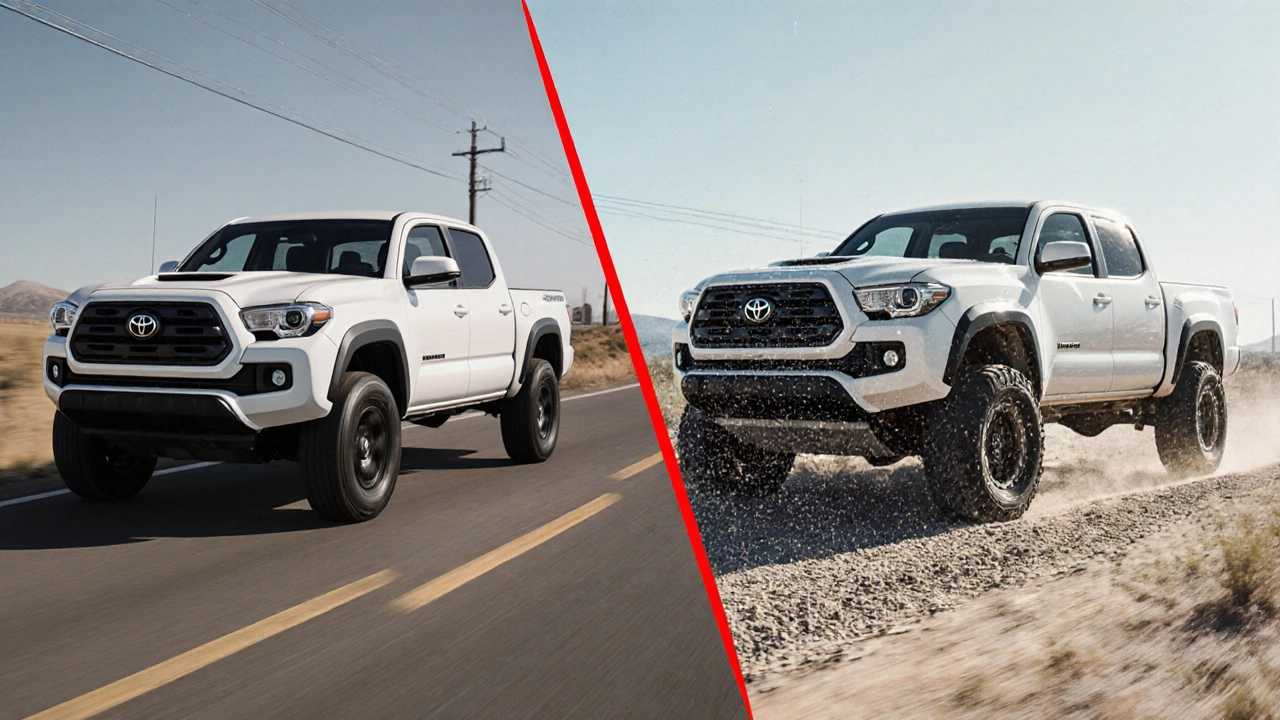Lift Kit Fuel Economy Calculator
Note: Based on data from real-world tests. A 2.5-inch lift with 35-inch tires typically causes 8-12% highway efficiency loss. See full data
When you slap a lift kit on your truck or SUV, you’re not just making it look tougher-you’re changing how it drives, handles, and yes, how much fuel it drinks. If you’re thinking about lifting your rig for better ground clearance or bigger tires, you need to know this upfront: lift kits almost always hurt gas mileage. It’s not a myth. It’s physics.
Why Lift Kits Kill Fuel Efficiency
Think of your vehicle like a car shaped like a brick. When you lift it, you’re raising the center of gravity and increasing the surface area that hits the wind. More wind resistance means the engine has to work harder to push through air. That’s drag, and drag eats fuel.
Let’s say you lift your 2023 Toyota Tacoma by 3 inches and swap in 33-inch tires. That might sound like a modest upgrade, but here’s what actually changes:
- Height increases by 7-10% → more frontal area exposed to wind
- Tire diameter grows by 10-15% → heavier, taller tires = more rotational mass
- Alignment shifts → tires scrub against the road instead of rolling cleanly
- Weight adds up → steel spacers, longer control arms, upgraded shocks = 100-200 extra pounds
That’s not just a little extra load. That’s a cascade of inefficiencies. A 2024 Ford F-150 with a 2.5-inch lift and 35-inch tires, tested by Truck Trend in 2024, saw a 12% drop in highway fuel economy-from 24 mpg down to 21.1 mpg. In city driving? It dropped even more: from 18 mpg to 15.6 mpg.
It’s Not Just the Lift-It’s the Tires
Most people blame the lift kit alone. But here’s the real culprit: the tires that come with it. Stock tires are designed for low rolling resistance. They’re narrow, lightweight, and have smooth tread patterns optimized for pavement.
Lift kits usually come paired with all-terrain or mud-terrain tires. These are heavier, wider, and have aggressive tread blocks that dig into dirt, sand, or rocks. That’s great off-road. Terrible on the highway.
Every extra pound of tire weight adds up. A single 35-inch all-terrain tire can weigh 45-55 pounds. Stock tires? More like 30-35 pounds. Multiply that by four, and you’re adding 60-100 pounds of rotating mass. That’s like carrying a full cooler in your trunk-except it’s spinning at 70 mph.
And tread pattern? Deep lugs create more friction. You’re not just rolling-you’re fighting the road. Studies from the Society of Automotive Engineers (SAE) show that switching from highway tires to aggressive all-terrain tires alone can cut fuel economy by 5-8%, even without any lift.
How Much Gas Mileage Do You Really Lose?
There’s no one-size-fits-all number, but here’s what most real-world tests show:
| Lift Height | Tire Size Increase | City MPG Loss | Highway MPG Loss |
|---|---|---|---|
| 1-2 inches | 1-2 inches | 3-6% | 4-7% |
| 2-3 inches | 2-3 inches | 6-10% | 8-12% |
| 4+ inches | 4+ inches | 10-15% | 12-18% |
That 15% loss on a 16 mpg truck? That’s 2.4 fewer miles per gallon. If you drive 15,000 miles a year and pay $1.80 per liter ($6.80 per gallon), you’re spending an extra $450-$600 a year on gas. For a 4-inch lift with 37-inch tires? That number jumps past $800.

What About Lift Kits With Aerodynamic Tweaks?
You’ve probably seen ads for “fuel-efficient lift kits” or “aero lift kits.” These are mostly marketing buzzwords. Some companies sell lift kits that include fender flares designed to smooth airflow, or wheel well liners to reduce turbulence. They help-but not enough to cancel out the damage.
Even the best aerodynamic upgrades only recover 1-2% of lost efficiency. That’s like trying to plug a leak in a boat with duct tape. The hole is still there. You’re just slowing the water down a little.
One 2024 test by Off-Road.com on a lifted 2022 Ram 1500 showed that adding a rear spoiler and smoothed fender flares improved fuel economy by 1.3 mpg-but only after a 14% drop from the lift and tires. Net loss? Still 12.7%.
Can You Offset the Loss?
Yes-but not easily, and not cheaply.
- Regear your differential: If you go from 32-inch to 35-inch tires, your transmission and engine are now spinning slower than designed. Installing a lower gear ratio (like 4.56:1 instead of 3.73:1) brings RPMs back into the sweet spot. This can recover 3-5% of lost efficiency. But it costs $1,500-$2,500, and you’ll need to do it on both axles if you have 4WD.
- Use low-rolling-resistance tires: Some all-terrain tires, like the Michelin LTX A/T2 or Goodyear Wrangler All-Terrain Adventure, are designed to be more fuel-efficient. They still cost you 3-5% compared to stock, but they’re the best compromise.
- Drive smarter: Cruise control on highways, avoid rapid acceleration, reduce idling, and keep tires properly inflated. These habits can save 5-10% on fuel, which helps-but won’t erase the lift penalty.
- Remove unnecessary weight: Take out roof racks, cargo carriers, or extra tools you don’t use. Every 100 pounds you shed improves fuel economy by about 1-2%.
None of these fixes are magic. They’re bandaids on a bigger wound. The lift kit still changed your vehicle’s fundamental design.

When the Trade-Off Makes Sense
Here’s the honest truth: most people lift their trucks not because they care about fuel economy. They do it because they want to go off-road, tackle steep trails, or just look like they can.
If you spend 80% of your time on dirt, mud, or snow, then a 15% drop in fuel economy is a fair trade for better traction and clearance. You’re not driving on highways-you’re driving where stock trucks can’t go.
But if you’re mostly on paved roads, commuting to work, or hauling groceries, then a lift kit is a financial mistake. You’re paying hundreds more per year in gas for a look that doesn’t improve your daily life.
And don’t forget the hidden costs: faster tire wear, increased brake wear, potential alignment issues, and even warranty voids. Some manufacturers will deny claims if they find a lift kit installed-even if it didn’t cause the problem.
What About Smaller Lifts?
A 1-inch leveling kit? It’s less damaging, but it still hurts. That small lift often comes with taller tires to fill the wheel well. Even a 1-inch lift with 32-inch tires can cost you 3-5% in fuel economy.
If you only want to level out the front end to fix the factory nose-down stance, consider a simple coil spacer or torsion bar tweak instead of a full lift kit. These don’t change the suspension geometry as drastically and tend to have less impact on fuel efficiency.
Bottom Line: Lift Kits = Less Gas Mileage
There’s no way around it. Lifting your vehicle reduces fuel economy. The bigger the lift and the larger the tires, the worse it gets. There’s no “magic” lift kit that doesn’t cost you gas. It’s not a debate-it’s science.
Ask yourself: Are you lifting for function or for fashion? If it’s function-off-road capability, trail riding, heavy-duty work-then the fuel cost is part of the price of doing business. If it’s fashion? You’re spending thousands on a look that’s costing you hundreds every year in gas, tires, and maintenance.
Before you buy that lift kit, do the math. Calculate your annual mileage, current fuel cost, and expected efficiency loss. Then ask: Is that extra ground clearance worth the extra $500 a year you’ll hand over to the gas station?”
Do all lift kits reduce gas mileage?
Yes, all lift kits reduce gas mileage to some degree. Even a 1-inch leveling kit changes aerodynamics and tire size, which increases drag and rolling resistance. The amount varies based on lift height, tire size, and added weight, but there’s no lift kit that improves fuel economy.
Can regearing fix fuel economy after a lift?
Regearing your differential can recover 3-5% of lost fuel efficiency by bringing engine RPMs back to optimal range. But it’s expensive ($1,500-$2,500), and you still won’t get back to stock mileage. It helps, but it doesn’t erase the loss.
Are there lift kits that don’t hurt fuel economy?
No. Even so-called “aero lift kits” or “fuel-efficient lifts” only minimize the damage-they don’t eliminate it. Any increase in height or tire size adds wind resistance and weight, which directly reduces efficiency. Marketing claims to the contrary are misleading.
How much does a 3-inch lift cost in gas per year?
A 3-inch lift with 35-inch tires typically cuts fuel economy by 8-12%. For a truck that gets 18 mpg stock, that’s about 16 mpg after the lift. If you drive 15,000 miles a year and pay $6.80 per gallon, you’ll spend roughly $550-$750 more per year on gas.
Should I avoid a lift kit if I commute daily?
If you spend most of your time on paved roads, yes-avoid it. The fuel cost, tire wear, and maintenance penalties outweigh the visual or minor off-road benefits. A leveling kit or stock suspension with better tires will give you most of the look without the cost.






